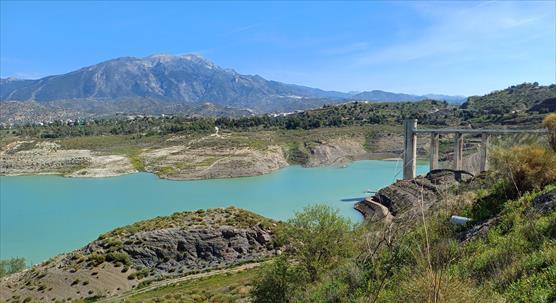What happens when efficiency targets are implemented in public water supply? How digital tools can help to control over abstraction of water supply and re-allocate scarce water resources between different users? Can impact investments be harnessed for water stewardship? GOVAQUA project will answer these questions in the 8th IAHR Europe Congress in Lisbon.

La Viñuela water reservoir serves 15 municipalities and 200,000 inhabitants in theAxarquía region in Andalusia. The drought in the area has lasted for 7 concecutive years. © Eija Järvinen
In one of the GOVAQUA project´s studies impact of implementation of efficiency targets in public water supply was studied by using energy consumption as an indicator. Leakages from water supply systems cause interconnected negative impacts such as over-extraction of water, increased energy and chemical consumption, and economic costs. Lowering water losses from the EU average (23%) decreases per capita energy consumption. Minimizing the water supply leakages holds significance for climate change adaptation by preserving non-abstracted water for future droughts and enhancing the quantitative condition of water bodies. Furthermore, the reduction of losses is intricately connected to energy and chemical consumptions, contributing to climate change mitigation. (Esther Díaz-Cano1 and Julio Berbel1)
In another study, the Axarquía region (Andalusia, Spain) acts as a Living Lab for testing governance innovations aiming at a sustainable management of water resources. Innovative water governance instruments can play a key role in accelerating a path to sustainability transition in water management. Preliminary results from the Living Lab are presented: benefits from the use of a new digital tool to overcome the challenges related to control of over abstraction and the re-allocation of scarce water resources and competition between users. (Damián Sánchez-García2 and Suvi Sojamo3)
Third study introduces impact investments to address water impacts of food production value chains and offers a timely exploration of how impact investments can be harnessed for water stewardship and water protection in general. By providing a context-sensitive analysis of impact investments tailored to a specific geographical setting, the study offers valuable insights and a general scheme that can be adapted and applied to other regions facing similar challenges. It underscores the potential of innovative financial mechanisms to drive meaningful environmental stewardship while maintaining economic growth and sustainability in the food production value chains. (Liisa Saikkonen3, Soile Oinonen3, Suvi Sojamo3, Outi Penttilä3 and Esther Díaz-Cano1)
All studies are part of the Horizon Europe project GOVAQUA, which aims to identify, assess, develop and validate innovative governance instruments and approaches to support and accelerate a transition towards sustainable and equitable water use in Europe. Such a transition is urgently required to reconcile water uses and environmental needs and to reach the aims of the EU WFD, the EU Green Deal and the UN SDGs. With putting innovative approaches into test in altogether six newly established Living Labs in collaboration with key stakeholders, the project aims to come up with good practices with European wide scaling up potential.
IAHR (International Association for Hydro-Environment Engineering and Research) Europe Congress takes place in Lisbon, Portugal 4–7 June 2024.
Recearch instutes involved in these GOVAQUA studies:
-
1 WEARE- Water, Environmental and Agricultural Resources Economics Research Group, Universidad de Córdoba, Spain
-
2 Cetaqua Andalucía, Spain
-
3 Finnish Environment Institute, Finland